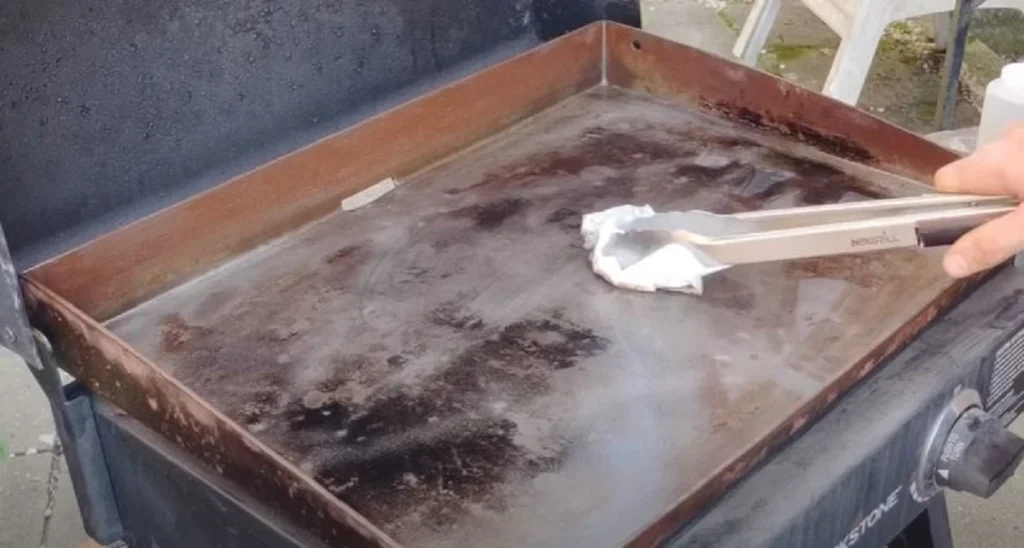| Note: This article may contain affiliate links, which means if you make a purchase following our links won’t cost you extra, but we may earn a commission. Learn more |
Your Blackstone griddle is rusting because of the interaction between water, oxygen, and iron. This process is accelerated in humid environments or when the griddle is frequently exposed to moisture.
Rust formation on Blackstone griddles is a common issue, often stemming from exposure to moisture and inadequate maintenance. To prevent rust, it’s essential to keep the griddle dry and properly seasoned. Seasoning forms a protective barrier that repels water and prevents rust.
After each use, clean the griddle and apply a thin layer of oil. This routine not only enhances the griddle’s longevity but also improves its non-stick properties, making cooking and cleaning easier.
If rust does appear, it’s not the end of your griddle’s life. Start by scrubbing the rusted areas with a stiff brush or steel wool. This action, done in a circular motion, helps to loosen and remove the rust.
Apply some pressure to ensure effective removal. After scrubbing, wash the griddle with soap and hot water to remove any loose rust particles and debris. Once clean, dry the griddle thoroughly to prevent further rusting.
To further protect your Blackstone griddle, store it in a dry place and use a cover to shield it from the elements.
Why Blackstone Griddles Rust?
Rust on Blackstone griddles is primarily caused by the natural process of oxidation, where iron in the griddle reacts with oxygen in the presence of water or moisture. This reaction is more pronounced if the griddle is frequently left outdoors, especially in humid or wet conditions.
The lack of a protective oil layer can also accelerate rusting. When the griddle is used, the high heat can strip away this protective layer, making it vulnerable to moisture in the air.
Food particles and grease left on the griddle can contribute to rust formation. These substances can trap moisture against the griddle’s surface, further promoting rust.
Rust Removal Tactics for Blackstone Griddles
Scrubbing the Surface
Begin by using a stiff brush or steel wool to scrub the rusted areas. This physical action helps to loosen and lift the rust from the griddle’s surface.
Applying Cleaning Solutions
After scrubbing, apply a mixture of water and vinegar or a specialized griddle cleaner to the surface. These solutions help to dissolve and remove any remaining rust particles.
Rinsing and Drying
Once the rust has been scrubbed off, rinse the griddle with water. It’s essential to dry the griddle thoroughly afterward to prevent new rust from forming.
Re-seasoning the Griddle
After cleaning and drying, re-season the griddle. This process involves coating the griddle with a thin layer of oil and heating it, which creates a protective barrier against moisture.

Keeping Your Blackstone Griddle Rust-Free
1. Regular Cleaning and Drying
Ensure your griddle is cleaned after each use. Remove food particles and grease, then dry it thoroughly to prevent moisture buildup.
2. Consistent Seasoning
Regularly season your griddle. Apply a thin layer of cooking oil after each cleaning and heat it to maintain the protective seasoning layer.
3. Proper Storage
Store your griddle in a dry, covered area. If possible, use a griddle cover to protect it from the elements, especially if stored outdoors.
4. Avoiding Direct Exposure to Elements
Minimize the griddle’s exposure to rain, snow, and extreme humidity. These conditions can accelerate rust formation.
5. Immediate Action on Rust Spots
Address rust spots as soon as they appear. Early intervention can prevent the spread of rust and reduce the effort needed for removal.
Learn More: Using Side Burners on the Grill: What Are the Benefits?
